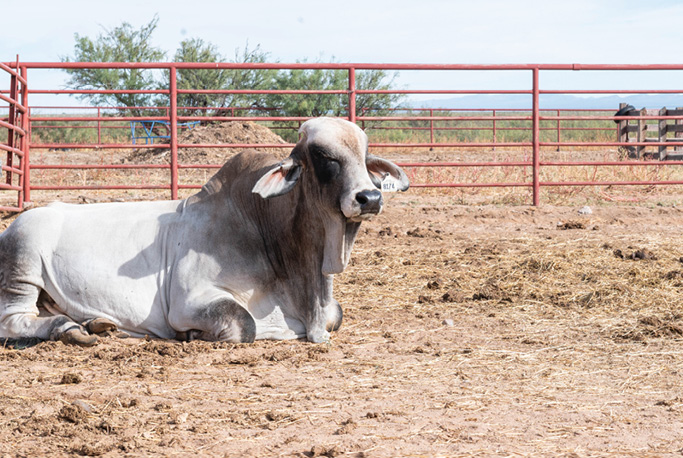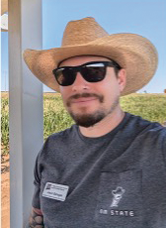Guide Z-130
Jason Banegas
College of Agricultural, Consumer and Environmental Sciences, New Mexico State University
Author: Extension Economist, Department of Agricultural Economics & Agricultural Business, New Mexico State University. (Print-friendly PDF)

Photo by Josh Bachman. NMSU, 2021.
Introduction
Organic beef consumption is projected to continue growing in the U.S. and abroad. Producers in New Mexico who can satisfy the United States Department of Agriculture’s National Organic Program (NOP) certification criteria and manage their cattle operations can benefit from this profitable market and have the opportunity to diversify their businesses. This snapshot of producer costs and incomes is not completely reliable as a benchmark for producers and data needs to be collected to create an accurate picture of cash flows for individual operations in this developing market. Producers that think this transition could fit their goals should make a plan that outlines the requirements for certification, identify the options that are available in their area with the available resources, and determine the costs and benefits unique to their operation. There is no standard way to complete a conversion to organic production, but many resources are available for those producers interested in the opportunity.1
In New Mexico and nationally there is a trend of increased inventory (Figure 1) and sales (Figure 2) of Organic Cattle (excluding cows), which suggests that specialty markets are growing and strengthening. The growth in sales and inventory in New Mexico suggests that current organic operations have successfully built a solid consumer base and formed supply chain partnerships, supporting the expansion of their enterprises. These established organic producers demonstrate that with effective strategies, a larger and more robust organic industry can thrive in the region. Rising consumer demand, along with continued innovation and sound management practices, opens opportunities for additional producers to enter this industry.
Revenue increases and risk reduction are possible for organic producers if they are able to participate in well-structured supply chains, however, the organic conversion process, production protocols, cost structures, and pricing practices vary greatly in different parts of the country so there is a knowledge gap in the characteristics and economics of organic beef ranches.5
“Organic producers may face additional challenges when trying to expand their business also. Supply can easily outpace demand in these smaller markets and often additional consumer research, education, and awareness building efforts are required to ensure that people value organic beef and increase their consumption. Additional costs associated with these expansion efforts could offset increased revenue but growing too fast is not one of the greater risks of this market.”2

Figure 1. U.S. and New Mexico Organic Cattle Peak Inventory (Head). 2008-2021
Source: https://quickstats.nass.usda.gov/
**No data for this year.

Figure 2. U.S. and New Mexico Organic Cattle Sales. 2008-2021
*Withheld to avoid disclosing data for individual operations. **No data
Funding and Financial Support
Financing organic cattle operations can involve working with lenders who are less familiar with the business model and risks associated with this type of beef production. Higher production costs, limited markets, certificate and compliance costs, higher marketing costs, and additional operations and maintenance costs of an organic beef cattle operation are just some of the characteristics that differentiate these businesses from commodity beef production. Enterprise farm and ranch budgets, such as those developed by NMSU extension economics, don’t often include the financial figures that can be directly utilized by organic operations.
Producers looking for assistance with an organic transition have many federal resources available. Organic farmers can apply for the same loans and programs as conventional farmers. USDA farm loans can be used to buy or lease land, buy equipment, build or upgrade storage facilities, and help with other operating costs.9 USDA programs focused on organic production include: the Transition to Organic Partnership Program (TOPP)11 that provides technical assistance and wrap-around support for transitioning and existing organic farmers, the Organic Certification Cost Share Program (OCCSP)12 that provides cost share assistance to producers and handlers of agricultural products who are obtaining or renewing their NOP certification, the Transitional and Organic Grower Assistance program (TOGA)8 provides insurance premium assistance for organic grain and feed crops, the Organic Transition Initiative (OTI)7 provides support during the 36 month transition period, and others.
The Natural Resources Conservation Service (NRCS) also has several programs such as: the Environmental Quality Incentives Program (EQIP)15 Organic Initiative that provides technical and financial assistance, the Conservation Stewardship Program (CSP)14, and the Agricultural Management Assistance (AMA) program.13
In addition to federal funding, the New Mexico Healthy Food Financing Fund (HFFF) has grants for producers. Five NM producers received HFFF awards for 2024.4 Private funding for organic beef producers may also be available from entities such as the Organic Farming Research Foundation or the New Mexico Farmers’ Marketing Association (NMFMA). USDA has a resource at https://www.farmers.gov/your-business/beginning-farmers/funding that can help with exploring financing options. Due to constantly changing funding sources/programs, producers interested in organic beef should seek the guidance of an NMSU extension agent, an NMDA employee, or a USDA representative familiar with current opportunities.
An NMSU Range Improvement Task Force (RITF) report found that 57% of organic beef producers financed part of their operation with off-farm income and the average percentage of total family income earned off-farm was 40%. Part-time producers received income from sources off-farm half of the time while only a quarter of full-time producers did. Financing challenges are common, and cash flow was found to be the biggest problem. Borrowing and increased cost of production were also difficulties identified by organic beef producers and about 40% of the respondents reported no financing problems.5
Securing funding for an organic beef cattle operation in New Mexico could be difficult without a detailed plan and additional assurances. Banks may not be able to compare accounts from commodity beef operations to specialty beef cattle operations or could be unable to identify best practices and assess performance against industry benchmarks. Producers should develop financial goals, create a cash flow analysis that assesses the sufficiency of revenue needed to meet obligations, and get advice on potential improvements. A ranch enterprise financial planning professional can assist organic beef producers build a financing portfolio. The portfolio is an evolving tool that can be used to show the rewards and risks of an unfamiliar business to lenders. Lenders will analyze risks associated with organic beef cattle by examining historical and projected income and expenses and can identify potential areas of vulnerability. Producers should develop risk mitigation strategies that include identification of cost-saving measures, optimization of resources, and diversification of income sources. A higher amount of collateral may be required, or a lower loan amount may be given for an organic beef cattle operation if it is determined that risks associated with the business are higher than more familiar commodity beef cattle operations.
Although there are challenges, there is also positive news for organic producers. In 2023, the USDA announced a $75 million investment in the Organic Market Development Grant (OMDG).10 This grant program will support development in organic markets by building and expanding capacity for certified organic production, aggregation, processing, manufacturing, storing, transporting, wholesaling, distribution, and development of consumer markets. “OMDG offers three project types, 24-month Simplified Equipment-Only with funding between $10,000 and $100,000. 3-year Market Development and Processing Capacity Expansion with funding ranging between $100,000 and $3,000,000.”10 The application deadline for the OMDG closed in August of 2023 but there are many resources that organic beef cattle producers can utilize from this program if it continues and there is support to pass the Organic Market Development Act as part of the 2024 Farm Bill and codify the program for extended appropriations. The Act will help solve persistent supply chain gaps and move value-added organic commodities to market.6
The USDA supports local and regional food systems by strengthening the supply chain and increasing market access to small and mid-sized agricultural businesses. In May 2024 the US Agriculture Secretary, Tom Vilsack, announced $10 million in additional funding for domestic organic production that will provide training to transitioning producers and ease organic certification.16 Beef cattle producers in NM may be able to take advantage of funding such as this in the future to facilitate organic innovations in their operations.
Expansion
Starting an organic beef operation can be as simple as identifying unmet demand for these premium products and providing a single animal’s worth of meat, however, expanding an organic operation in New Mexico can be challenging due to the unique financial needs, production practices, and market considerations in the state. Achieving economies of scale in niche production while maintaining practices can be challenging. Higher production costs associated with organic methods may impact the viability of expanding an operation. Expenses related to organic inputs, feeding practices, and adherence to certification standards may not benefit from the same economies of scale as commodity beef production methods.
Resource availability for an expanding organic beef producer is also a concern. Land and water are two critical components of carrying capacity. Increasing herd size usually means increasing grazing land while also meeting productivity and regulatory requirements. Pasture management can be more complicated during expansion and maintaining reliable organic feed sources is necessary to meet NOP standards. Feed, water, labor, record keeping, facilities, equipment concerns, and health issues can be exacerbated in a larger herd. Preventative practices and health monitoring will be more complex with expansion.
Maintaining cash flow and risk management strategies are areas that should be thoroughly assessed before an expansion plan is implemented. A feasibility study will address issues with expenses and revenue streams and a contingency plan should be developed for any potential difficulties such as beef market downturns, prolonged drought, disease outbreaks, or other disruptions.
The supply chain coordination necessary for expanding an organic beef cattle operation becomes more complex with scale. Maintaining mutually beneficial transactions with processing facilities that meet certification standards can be challenging as production scales up. Relationships with distributors and retailers could also be affected when negotiating contracts for larger transactions. A farm and ranch development specialist can assess the financial and operational health of an organic beef cattle business and can make recommendations to prepare for increased production if possible.
Conclusion
The overall beef market is growing more complex due to “extensive branding efforts and development of niche markets, and demand for production of beef representing grass-fed, non-hormone, non-antibiotic, and organic beef markets is growing steadily.”3 For ranchers aiming to enter the organic beef market, securing financing is essential to cover the costs associated with organic certification, infrastructure improvements, and production adjustments needed to meet USDA organic standards. With a well-tailored financial strategy, New Mexico ranchers can effectively balance the costs and benefits associated with organic beef production, positioning themselves for profitability and growth within this expanding market.
To obtain more information on financing and expansion opportunities for organic beef cattle in New Mexico you can reach out to a NMSU extension specialist, or contact the New Mexico Department of Agriculture, the New Mexico Livestock Board, the New Mexico Cattle Growers Association, or the New Mexico Beef Council.
References
- Banegas, J. (2024) Opportunities and Management Strategies for New Mexico Beef Cattle Producers Considering an Organic Transition (Part 1 of 3) Organic Beef Market Basics (Guide Z-126). NMSU Cooperative Extension Service. https://pubs.nmsu.edu/_z/Z126/index.html
- Banegas, J. (2024) Opportunities and Management Strategies for New Mexico Beef Cattle Producers Considering an Organic Transition (Part 2 of 3) Organic Beef Market Basics (Guide Z-127). NMSU Cooperative Extension Service. https://pubs.nmsu.edu/_z/Z127/index.html
- Drouillard, J.S. (2018). Current Situation and Future Trends for Beef Production in the United States of America - A Review. Asian-Australasian Journal of Animal Sciences, 31(7), 1007–16. https://doi.org/10.5713/ajas.18.0428
- Economic Development Department. (2023). Fiscal Year 2024 Healthy Food Financing Fund Awardees. https://edd.newmexico.gov/business-development/edd-programs-for-business/finance-development/fy24hfff-awardees/
- Roberts, C., Spurgeon, C., Fowler, J. (2007). Characteristics of the United States Organic Beef Industry (Report 67). New Mexico State University Range Improvement Task Force. https://pubs.nmsu.edu/_ritf/RITF67.pdf
- Tammy Baldwin United States Senator for Wisconsin. (2023, September 27). Baldwin, King, Kuster, Pingree Introduce Bill to Support Organic Farmers and Producers to Meet Growing Demand [Press Release]. https://www.baldwin.senate.gov/news/press-releases/baldwin-king-kuster-pingree-introduce-bill-to-support-organic-farmers-and-producers-to-meet-growing-demand
- U.S. Department of Agriculture. (2022). Organic Transition Initiative (OTI). https://www.farmers.gov/your-business/organic/organic-transition-initiative
- U.S. Department of Agriculture. (2022). Transitional and Organic Grower Assistance Program (TOGA). https://www.farmers.gov/archived/your-business/organic/organic-transition-initiative/toga
- U.S. Department of Agriculture. (2021). Organic Agriculture Resources for Organic Farmers. https://www.farmers.gov/your-business/organic
- USDA Agricultural Marketing Service. (n.d.). Organic Market Development Grant (OMDG). Retrieved 2025, February 6, from https://www.ams.usda.gov/services/grants/omdg
- USDA Agricultural Marketing Service. (n.d.). Transition to Organic Partnership Program. Retrieved 2025, February 6, from https://www.ams.usda.gov/services/organic-certification/topp
- USDA Farm Service Agency. (n.d.). Organic Certification Cost Share Program (OCCSP). Retrieved 2025, February 6, from https://www.fsa.usda.gov/resources/programs/organic-certification-cost-share-program-occsp
- USDA National Resource Conservation Service (NRCS). (n.d.). Agricultural Management Assistance. 2025, February 4, from https://www.nrcs.usda.gov/programs-initiatives/ama-agricultural-management-assistance
- USDA National Resource Conservation Service (NRCS). (n.d.). Conservation Stewardship Program. Retrieved 2025, February 4, from https://www.nrcs.usda.gov/programs-initiatives/csp-conservation-stewardship-program
- USDA National Resource Conservation Service (NRCS). (n.d.). Environmental Quality Incentives Program. Retrieved 2025, February 5, from https://www.nrcs.usda.gov/programs-initiatives/eqip-environmental-quality-incentives
- USDA. (2024, May 15). Easing Producers’ Transition to Organic Production with New Programs and Partnerships, Announces Investments to Create and Expand Organic Markets [Press Release]. https://www.usda.gov/media/press-releases/2024/05/15/usda-easing-producers-transition-organic-production-new-programs
Read Part 1: Organic Beef Marketing Basics
Read Part 2: Organic Beef Production Basics

Jason Banegas is an NMSU Extension Economist specializing in statewide forecasting. He earned a master’s degree in economics from the University of Oklahoma and is in the NMSU Doctor of Economic Development program and the NMSU Water Science and Management Ph.D. program. His Extension work provides current research-based information to New Mexico livestock and crop producers to enhance profitability and farm and ranch sustainability. With input from producers, industry representatives, researchers, extension agents, and other stakeholders he transforms data into usable guides and tools.
To find more resources for your business, home, or family, visit the College of Agricultural, Consumer and Environmental Sciences on the World Wide Web at pubs.nmsu.edu.
Contents of publications may be freely reproduced, with an appropriate citation, for educational purposes. All other rights reserved. For permission to use publications for other purposes, contact pubs@nmsu.edu or the authors listed on the publication. New Mexico State University is an equal opportunity employer and educator. NMSU and the U.S. Department of Agriculture cooperating.
March 2025. Las Cruces, NM.


